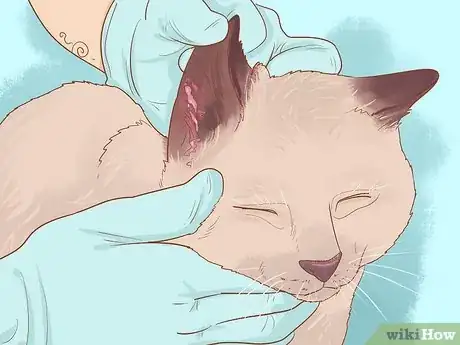This article was co-authored by Molly DeVoss and by wikiHow staff writer, Caroline Heiderscheit. Molly DeVoss is a Certified Feline Training and Behavior Specialist (CFTBS), a Certified Cat Behavior Consultant (CCBC), a Fear Free Certified Trainer (FFCT), and the Founder of Cat Behavior Solutions. Molly specializes in using positive reinforcement to modify and prevent unwanted behaviors in cats and reduce cat shelter surrender. Molly has sat on the Dallas Animal Advisory committee since 2013 and was voted one of the Top 12 Extraordinary Cat Behaviorists of 2020 by Catpetclub.com. She is certified by both the Animal Behavior Institute and the International Association of Animal Behavior Consultants. She is also the host of the weekly podcast Cat Talk Radio.
There are 17 references cited in this article, which can be found at the bottom of the page.
This article has been viewed 1,678 times.
If you've been thinking about temporarily caring for a sweet, silly, furry friend, we think that's an amazing idea. If you're looking into this, you clearly have a huge heart—but what about the logistics of fostering? Don't worry, we're going to cover absolutely everything you need to know. We'll walk you through why fostering is important, how you can register, fostering responsibilities, preparing your home, and finally, the cost. That way, you can focus on what's really important: caring for a cat in need!
Steps
Why foster a cat?
-
1You make room for another cat in the shelter. When you welcome a new furry friend into your home, you free up resources at your local shelter. This means one more homeless cat off the streets—so when you foster, you’re offering a warm bed, food, and shelter to a stray cat.[1]
-
2You introduce cats to more potential adoptive parents. When you foster, you give all of the people in your life a chance to fall in love with your furry friend. The more people a cat meets, the higher chance they meet someone who’s ready to adopt.[2]
- Plus, you can raise their chances by posting all of their sweetest, funniest moments on social media—one of your followers could be your foster cat’s forever home!
Advertisement -
3You give the cat more attention than they’d have in the shelter. With so many animals, shelters are unable to offer as many pets, scratches, and playtimes as they'd like. When a foster cat comes to stay with you, you majorly improve their quality of life by offering them love and care. And that’s something to celebrate![3]
Registering to Be a Foster
-
1Find a local shelter. Visit the ASPCA national database to learn more about all of the best shelters in your area.[8] Then, search online for reviews to give you a better sense of the shelter’s reputation. If you know anyone who’s fostered locally, reach out to them. They can give you more insight into what it’s like working with a specific shelter.
- Some shelters offer permanent/hospice foster situations and others might stick to standard, short-term arrangements. Make sure your pick suits your schedule.
- On top of that, every institution will have it's own policies and requirements. Before you proceed, call into your shelter to make sure their expectations align with yours.
-
2Fill out the application. Here, give basic information on your financial status, your work schedule, and your foster cat preferences (age, health status, behavioral, etc.). You’ll also need to meet the shelter’s eligibility requirements. This will usually mean an age requirement, often between 18-21. They may also ask that you keep the cat indoors, don’t have kids, or have no other pets.[9]
- Note that some shelters may ask you to pay an application fee.
-
3Fulfill the interview requirement. If they ask, accept a call or meet up to answer some questions for your local shelter. This is a great opportunity to talk about expectations and requirements so you know for sure that you’re excited to proceed. The shelter will likely ask you to expand on some of your application answers as well.[10]
- Note that some shelters may require you to complete a background check or submit personal references.
-
4Complete the shelter’s orientation or informational class. To give you all of the background you need and to answer all of your burning questions, shelters will almost always ask that you take a quick course. Take your course online or in-person and expect it to last just an hour or two. They’ll cover tons of important info, from medical tips to socialization.[11]
- Note that some shelters may ask you to watch a video and pass a quiz.[12]
-
5Get matched with your cat. Once you’re all cleared, reach out and inform them that you’re ready to foster. Then, wait until your local shelter calls—they’ll let you know when they've found a potential match. If your contact doesn’t cover details about the individual cat that you’d like to know, ask them now. Make sure that you feel comfortable with the cat's health, behavioral, and social needs.[13]
Responsibilities of Fostering a Cat
-
1Keep your cat healthy by taking them to their required vet check-ins. Typically, this will be around every 2-4 weeks. This vet check-in process is designed to ensure that your cat stays happy and healthy. You’ll be required to take them in with your own transportation. Reach out to your local shelter to learn more about their specific vet appointment requirements.[14]
- Be on the lookout for signs that your cat needs emergency help. This could be broken bones, trouble standing, or difficulty breathing.
- In all likelihood, you’ll have reviewed an emergency medicine protocol with your shelter, so you’ll know exactly what to do.
-
2Look out for health issues and keep the shelter updated. Communicate with your shelter’s fostering coordinator if you witness any symptoms that might be cause for concern. Depending on the shelter, you may need to have additional vet visits approved—but either way, their expert knowledge can help you navigate the situation. Reach out if you notice:[15]
- Eye discharge
- Sneezing
- Hair loss
- Loss of appetite
- Diarrhea
- Vomiting
-
3Provide food and water for your cat. Cats typically eat 2 meals a day, around 12 hours apart. On top of that, they require access to clean water on the daily. Making sure your foster cat stays well fed and hydrated is a key responsibility of cat fosterers.[16]
- Sitting with your cat during meals is a great way to bond and build trust with them.[17]
-
4Clean the litter box daily and keep their area clean. Give your cat access to a litter box and make sure they're living in a sanitary area at all times. This means that if your cat gets sick or has an accident, it’s important to clean the mess right away.[18]
- Cleaning the litter box every day can help minimize odors.
- One of the benefits of fostering an adult cat is that they’re likely already trained with their litter box—but not necessarily. Speak to your shelter about your cat’s history using the litter box and remember, patience will be a must if you’re looking to foster a furry friend.
- Note that if you buy clay litter, you may only need to clean the box once every 2 weeks.
-
5Give your cat tons of love, cuddles, and fun. If you’re fostering a cat, you’re expected to provide them with social interaction and playtime. This just means that you’ll need to be generous with toys, pets, and scratches. Let’s be honest, though—you’ll probably love fulfilling this requirement![19]
- At a minimum, aim for 2-3 20 minute social visits with your foster cat per day. This means petting, cuddles, and scratches.
- Then, use toys to play with your cat 1-2 times per day.
- Give your cat plenty of space, treats, and reassurance if they're shy.[20]
How to Prepare Your Home
-
1Buy a cat bed, food, bowls, treats, toys, a cat brush, and a scratching post. Some shelters may provide these for you, and some may require that you purchase these necessities out of pocket. Look in a pet shop, a superstore, or online to find your cat essentials and then, set them up in your cat’s room. Follow these pro tips for extra help:
- If you have more than one can in your home, aim to have separate food and water bowls for every animal.
- Grab a few toys that cats can’t swallow, that way you can leave them in the room with your cat during the day (ping pong balls are a great option!).
- If you’re having trouble getting your cat to sleep in their cat bed, ask your shelter for a blanket or toy your cat has used before. Lay it in your cat bed. This way, the bed’s scent will be more familiar.
- Ask the shelter for advice and recommendations if you’re not sure where to start.
- Make sure that your cat has plenty of environmental enrichment as you set up their living space! This includes quiet places to rest, multiple soft beds, high places to explore, scratching devices, food puzzles, toys, and treats.[21]
-
2Purchase and set up the litter box. Even if you already have a pet cat, buy a new litter box for your foster. As a rule of thumb, always have one more litter box in your home than you have cats. Where you place your litter box is also super important—make sure it's as far from your cat’s bedding and food as possible within their designated space. Then, make sure you choose a quiet, peaceful part of your home (AKA, not somewhere that gets a ton of foot traffic).[22]
-
3Cat-proof your home. Take steps to remove dangers from your cat’s room and throughout your house. This will help you keep your cat safe from your items—and keep your items safe from your cat, too! Before bringing a foster cat into your home, run through this checklist:[23]
- Block outlets and take care of electrical wires
- Remove items that a cat could swallow, like string or buttons
- Put away your house plants, because many are toxic to cats
- Block small holes where your cat could get stuck
- Close aquarium and animal cages
- Secure window latches
- Remove breakable items—especially those sitting on shelves
- Put away medications and lotions
- Keep toilet lids closed
Expert Q&A
-
QuestionHow do I stop my cat from going on the kitchen worktop?
 Molly DeVossMolly DeVoss is a Certified Feline Training and Behavior Specialist (CFTBS), a Certified Cat Behavior Consultant (CCBC), a Fear Free Certified Trainer (FFCT), and the Founder of Cat Behavior Solutions. Molly specializes in using positive reinforcement to modify and prevent unwanted behaviors in cats and reduce cat shelter surrender. Molly has sat on the Dallas Animal Advisory committee since 2013 and was voted one of the Top 12 Extraordinary Cat Behaviorists of 2020 by Catpetclub.com. She is certified by both the Animal Behavior Institute and the International Association of Animal Behavior Consultants. She is also the host of the weekly podcast Cat Talk Radio.
Molly DeVossMolly DeVoss is a Certified Feline Training and Behavior Specialist (CFTBS), a Certified Cat Behavior Consultant (CCBC), a Fear Free Certified Trainer (FFCT), and the Founder of Cat Behavior Solutions. Molly specializes in using positive reinforcement to modify and prevent unwanted behaviors in cats and reduce cat shelter surrender. Molly has sat on the Dallas Animal Advisory committee since 2013 and was voted one of the Top 12 Extraordinary Cat Behaviorists of 2020 by Catpetclub.com. She is certified by both the Animal Behavior Institute and the International Association of Animal Behavior Consultants. She is also the host of the weekly podcast Cat Talk Radio.
Certified Feline Training and Behavior Specialist & Certified Cat Behavior Consultant Certified Feline Training and Behavior Specialist & Certified Cat Behavior ConsultantExpert AnswerGive your cat replacement activity to do instead of climbing on the counter. You can also set up deterrents, like pressure-sensitive noise mats, double-sided tape on placemats, and a remote-controlled loud noise maker.
Certified Feline Training and Behavior Specialist & Certified Cat Behavior ConsultantExpert AnswerGive your cat replacement activity to do instead of climbing on the counter. You can also set up deterrents, like pressure-sensitive noise mats, double-sided tape on placemats, and a remote-controlled loud noise maker.
References
- ↑ https://www.aspca.org/blog/seven-reasons-why-fostering-animals-saves-lives
- ↑ https://www.aspca.org/blog/seven-reasons-why-fostering-animals-saves-lives
- ↑ https://www.aspca.org/blog/seven-reasons-why-fostering-animals-saves-lives
- ↑ http://cchumane.org/wp-content/uploads/faq%20when%20considering%20fostering%20an%20animal.pdf
- ↑ https://www.furryfriendsnetwork.org/foster/fostering/
- ↑ https://financialgym.com/blog/2020/4/27/costs-to-consider-when-adopting-vs-fostering-a-pet
- ↑ https://fosterfurkids.com/foster-how-it-works
- ↑ https://www.aspca.org/adopt-pet/find-shelter
- ↑ https://www.preventivevet.com/cats/foster-cat-application-process
- ↑ https://www.preventivevet.com/cats/foster-cat-application-process
- ↑ https://www.preventivevet.com/cats/foster-cat-application-process
- ↑ https://www.aspca.org/get-involved/volunteer/kitten-fostering-aspca-los-angeles
- ↑ https://www.preventivevet.com/cats/foster-cat-application-process
- ↑ https://www.aspca.org/get-involved/volunteer/kitten-fostering-aspca-los-angeles
- ↑ https://resources.bestfriends.org/article/cat-foster-care-manual#Medical
- ↑ https://vcahospitals.com/know-your-pet/feeding-times-and-frequency-for-cats
- ↑ https://www.sfspca.org/sites/default/files/documents/cat_affection-eaters.pdf
- ↑ https://www.humanesociety.org/resources/preventing-litter-box-problems
- ↑ https://pawshumane.org/wp-content/uploads/2015/03/Cat-Foster-Guide.pdf
- ↑ https://resources.sdhumane.org/Resource_Center/Behavior_and_Training/Cats_and_Kittens/Adopting_a_Cat_Things_to_Consider/Adopting_Shy_and_Fearful_Cats
- ↑ https://resources.bestfriends.org/article/enrichment-ideas-activities-and-products-indoor-cats
- ↑ https://www.preventivevet.com/cats/how-to-set-up-your-cats-litter-boxes-to-prevent-potty-accidents
- ↑ https://resources.bestfriends.org/article/cat-foster-care-manual#Preparing







































































